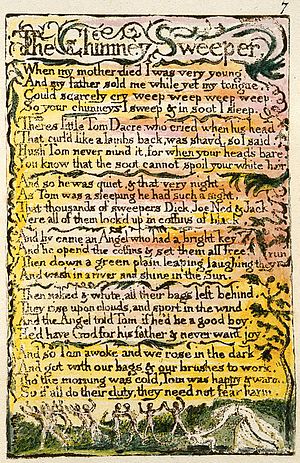
The Chimney Sweeper
We found 4 free papers on The Chimney Sweeper
Essay Examples
Overview
William Blake: Analysis of his Works and Visions
The Chimney Sweeper
William Blake
William Blake is said to be a very visual artist and in his visions, is where he got all of his ideas. In this essay Im going to explore some of Blakes works and the visions that caused him to write about some of the things that he wrote about. William Blake, born November 28,…
How does Blake use form, structure and language for effect in the Songs of Innocence?
Structure
The Chimney Sweeper
Blake employs various literary devices in “Songs of Innocence” in order to deeply impact the reader. The symbolism used in the poems is most evident in the representation of children as a symbol for purity and uncorruptedness in society. Blake employs various devices, such as questions and answers and a childlike style, to create an…
Blake – Songs of Innocence and Experience: the Chimney Sweeper
Experience
The Chimney Sweeper
William Blake, an innovative and proficient poet and engraver, possessed ideas that were ahead of his era. He authored two poetry collections known as The Songs of Innocence and The Songs of Experience. Despite their initial aim for children, The Songs of Innocence were eventually merged with The Songs of Experience to tackle the urgent…
Social Issue, Symbols, and Themes of Blake’s “the Chimney Sweeper” Poems Analysis
Poem
The Chimney Sweeper
Social Issue, Symbols, and Themes of Blake’s “The Chimney Sweeper” Poems During the seventeenth century, people in England substituted burning wood with coal to use their fireplaces to avoiding paying hearth taxes. The burning of coal left soot on the interior walls of the fireplaces that needed to be removed to keep the fireplaces clean….
| information | Short summary on The Chimney SweeperThe Chimney Sweeper was written by William Blake in 1789. The poem is told from the perspective of an enslaved boy who has been sold into servitude as a chimney-sweeper. The poem begins with the narrator describing his life as a chimney-sweeper. He describes how he and the other boys are forced to climb up and down the chimneys, cleaning out soot with their bare hands. The boys work long hours and spend most of their time covered in soot from head to toe. The narrator then tells us about his childhood, describing how he was sold into servitude by his father when he was just five years old. His mother passed away shortly after giving birth to him, leaving him alone with his father who didn’t know how to raise children on his own. The man struggles as he tries to provide for himself and his son; eventually he sells his son into slavery because he cannot afford to pay rent any longer or feed them both properly. The boy tells us that he hates this life and dreams of someday escaping it but knows that such dreams are impossible because there are no options available for someone like him. |
|---|
Frequently Asked Questions about The Chimney Sweeper
Don't hesitate to contact us. We are ready to help you 24/7

